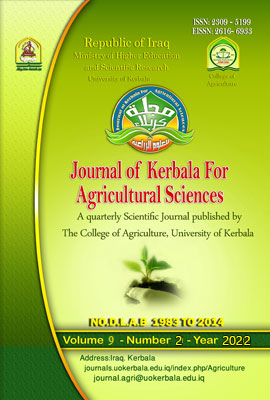FASN gene polymorphism and its relationship with milk yield and Composition in the Iraqi Awassi sheep
DOI:
https://doi.org/10.59658/jkas.v9i2.960Abstract
This study was conducted at the Barakat Abu Fadl al-Abbas (peace be upon him) sheep breeding station / Al-Kafeel General Investment Company in Karbala Governorate for the period from 1/12/2020 to 1/6/2021, with the aim of determining the Frequency of Alleles and Genetic Manifestations of the FASN gene and its relationship to milk production and its main components from The percentage of fat, protein, lactose and non-fat solids in Iraqi Awassi sheep, 51 female Awassi sheep were used in this study. The percentage of distribution of genotype for the FASN gene in the studied Awassi sheep sample was 7.84, 21.57 and 7.59% for each of the structures AA, AC and CC, respectively, and the two alleles were A and C, with a frequency of 0.19 and 0.81. respectively, significant differences were found in total milk production. As for the milk components, only the protein percentage was affected significantly by the different genotype, and there was no significant effect for the other components by the different genotype of the FASN gene. From the results of the current study, it can be concluded that the FASN gene can be adopted as an important indicator in the development of genetic improvement strategies for Awassi sheep to maximize the economic return from breeding projects by selecting and cross-breeding the genotypes that achieved the best productive performance.
Downloads
Published
How to Cite
Issue
Section
License
Copyright (c) 2022 Copyright (c) 2024 is the Author's article. Published by the Journal of Kerbala for Agricultural Sciences under a CC BY 4.0 license

This work is licensed under a Creative Commons Attribution 4.0 International License.
Licensing Terms
All articles are published under a Creative Commons License and will be directed to the Creative Commons Attribution 4.0 International License (CC BY 4.0) That permits use, distribution, and reproduction in any medium, provided the original work is properly cited. This license also allows the work to be used for commercial purposes.
Use by both non-commercial and commercial users
This content is licensed under a Creative Commons Attribution 4.0 International (CC BY 4.0) license, permitting use by both non-commercial and commercial users. Individual users may access, download, copy, display, and redistribute the articles to colleagues, as well as adapt, translate, and text- and data-mine the content, subject to the following conditions:
- The author's moral rights, including the right of attribution and the right to protect their work from derogatory treatment, are respected.
- Where content in the article is identified as belonging to a third party, users must ensure that any reuse complies with the copyright policies of the owner of that content.
- If the article content is reused for research or educational purposes, users should maintain a link to the appropriate bibliographic citation, including the DOI and a link to the published version on the journal's website.

